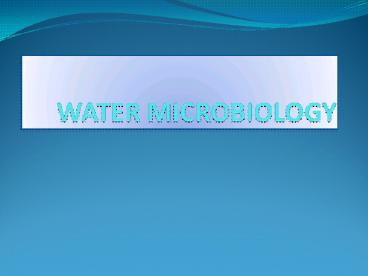WATER MICROBIOLOGY - PowerPoint PPT Presentation
1 / 25
Title:
WATER MICROBIOLOGY
Description:
Indigenous Water Microorganisms: Species of microorganisms that exist in water ... water) phyto and zooplankton, fungi, ultramicrobacteria or nanomicrobacteria ... – PowerPoint PPT presentation
Number of Views:6360
Avg rating:5.0/5.0
Title: WATER MICROBIOLOGY
1
WATER MICROBIOLOGY
2
DEFINITIONS
- Potable Water Drinkable water free from
pathogens, free from debris, taste and odor - Safe Water Free from pathogens
- Polluted Water Possibility of pathogenic
microorganisms - Contaminated Water Known pathogens present or
indicator organisms present
3
- Indigenous Water Microorganisms Species of
microorganisms that exist in water depend on the
O2 gradient, nutritional environment, pH and
temperature - Marine (97 of Earths water) phyto and
zooplankton, fungi, ultramicrobacteria or
nanomicrobacteria (Sphingomonas lt 0.2
micrometers), virioplankton (mostly
bacteriophages 10X the number of bacteria) - Marine microorganisms may be the source of new
antibiotics - Freshwater cyanobacteria, anoxygenic
phototrophic bacteria, algae
4
SOURCES OF WATER
- Atmospheric Water rain water
- microbiological quality
- Standing Water
- Surface Water lakes, rivers, reservoirs
- microbiological quality
- Underground Water aquifers, underground streams
- microbiological quality
5
PROBLEMS
- 1. Organisms resistant to chlorine or other
methods of disinfection - viruses, protozoan cysts, bacterial spores,
- organisms with extensive glycocalyx
- protection from biofilms
- clumps of bacteria
- antibiotic resistance associated with these
organisms
6
- EXAMPLES
- enteroviruses
- rotavirus
- Giardia
- Cryptosporidium
- Pseudomonas
7
- 2. Low dosage organisms
- EXAMPLES
- viruses enterovirus, rotavirus, Hepatitis
- Campylobacter
- Shigella
- Giardia lamblia
- Cryptosporidium
- Entamoeba histolytica
- Escherichia coli 0157H7
8
Indicator organismsThe presence of these
organisms indicate contamination
- An Ideal Indicator
- 1. Should be associated with source of the
pathogen - 2. Be present when the pathogen is present at
all times - 3. Be absent when the pathogen is absent
- 4. Be easily detectable
- 5. Be present in greater quantities than the
pathogen - 6. Not multiply
- 7. Survive better than the pathogen does
9
- Coliform most commonly used fecal indicator
organism - An anaerobic or facultatively anaerobic non
spore forming Gram negative rod that ferments
lactose with the production of gas in 24 - 48
hrs. at 35 C or which creates a metallic green
sheen or pink mucoid colonies with dark centers
on ENDO or EMB agar - Fecal coliform same definition only at 44 C
10
- Other indicator organisms
- Fecal streptococci - Enterococci
- Thermotolerant E. coli
- Coliphage
11
- Tests for Water
- Turbidity
- Free Residual Chlorine
- MPN Most probable number
12
MULTIPLE TUBE METHOD/MPN
- Presumptive Test
- Inoculate a specified number of lactose broths
with durham tubes with a specified amount of
water - Usually a total of 15 tubes
- 5 tubes with 10 ml
- 5 tubes with 1 ml
- 5 tubes with 0.1 ml
- Incubate at 35 C for 24 to 48 hrs
13
Fig. 41.2
14
- Confirmed Test
- Tubes with gas are inoculated into Brilliant
Green Lactose Bile broth with durham tubes - Incubated for 24 to 48 hrs
- OR
- Tubes with gas inoculated onto ENDO or EMB agar
and incubated
15
- Completed Test
- Tubes with gas are inoculated onto ENDO or EMB
and incubated - Colonies with metallic green sheen or pink
mucoid colonies with dark centers are inoculated
onto tryptic soy agar and in lactose broth
16
CONTINUATION OF THE MPN
- Colonies are Gram stained
- IMViC tests are done to determine if colonies are
E. coli or other bacteria - Numbers of organisms are determined by taking the
number of tubes in each category of water (10 ml,
1 ml, and 0.1 ml) and using a statistical chart - Counts given in number of organisms per 100 ml
17
MEMBRANE FILTRATION
- Filter water through 0.45 micrometer pore size
membrane filter and incubate on ENDO agar
18
INJURY RECOVERY TECHNIQUES
- use 2 layer agar
- use 2 incubation temperatures
19
OTHER TESTS
- Presence-Absence Test (P-A Test)
- 100 ml. incubated in triple strength-broth
containing lactose broth, lauryl tryptose broth,
and bromcresol purple indicator - positive result - production of acid (turns
yellow) - Colilert
- 100 ml. incubated in medium containing ONPG and
MUG as only nutrients - If coliforms present the medium tuns yellow
within 24 hrs. - If E. coli is present the medium will become
fluorescent under UV light
20
Fig. 41.3
21
HETEROTROPHIC PLATE COUNT (HPC)
- plate water to get a total count of organisms per
ml. - does not determine if organisms are pathogens,
but may help in determining if water treatment
process is working or indicate other problems
22
OTHER TESTS
- Psychrophiles
- plate count incubated below room temperature
- Low nutrient
- plate count using low nutrient agar - R2A
23
STANDARDS
- coliforms
- 1 found in lt 40 samples/month
- lt 5 positives found if gt 40 samples/month
- no fecal coliforms, enterococci, viruses, Giardia
24
WATER TREATMENT PROCESS
- 1. Sedimentation
- 2. Aeration
- 3. Chemical coagulation - use of a flocculating
agent - 4. Filtration
- 5. Method of Disinfecting (still have to add
chlorine - bec. of requirement for residual chlorine)
- Chlorination, Ozone, Other
25
Fig. 41.1































